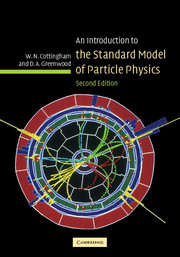Book contents
- Frontmatter
- Contents
- Preface to the second edition
- Preface to the first edition
- Notation
- 1 The particle physicist's view of Nature
- 2 Lorentz transformations
- 3 The Lagrangian formulation of mechanics
- 4 Classical electromagnetism
- 5 The Dirac equation and the Dirac field
- 6 Free space solutions of the Dirac equation
- 7 Electrodynamics
- 8 Quantising fields: QED
- 9 The weak interaction: low energy phenomenology
- 10 Symmetry breaking in model theories
- 11 Massive gauge fields
- 12 The Weinberg–Salam electroweak theory for leptons
- 13 Experimental tests of the Weinberg–Salam theory
- 14 The electromagnetic and weak interactions of quarks
- 15 The hadronic decays of the Z and W bosons
- 16 The theory of strong interactions: quantum chromodynamics
- 17 Quantum chromodynamics: calculations
- 18 The Kobayashi–Maskawa matrix
- 19 Neutrino masses and mixing
- 20 Neutrino masses and mixing: experimental results
- 21 Majorana neutrinos
- 22 Anomalies
- Epilogue
- Appendix A An aide-mémoire on matrices
- Appendix B The groups of the Standard Model
- Appendix C Annihilation and creation operators
- Appendix D The parton model
- Appendix E Mass matrices and mixing
- References
- Hints to selected problems
- Index
5 - The Dirac equation and the Dirac field
Published online by Cambridge University Press: 05 September 2012
- Frontmatter
- Contents
- Preface to the second edition
- Preface to the first edition
- Notation
- 1 The particle physicist's view of Nature
- 2 Lorentz transformations
- 3 The Lagrangian formulation of mechanics
- 4 Classical electromagnetism
- 5 The Dirac equation and the Dirac field
- 6 Free space solutions of the Dirac equation
- 7 Electrodynamics
- 8 Quantising fields: QED
- 9 The weak interaction: low energy phenomenology
- 10 Symmetry breaking in model theories
- 11 Massive gauge fields
- 12 The Weinberg–Salam electroweak theory for leptons
- 13 Experimental tests of the Weinberg–Salam theory
- 14 The electromagnetic and weak interactions of quarks
- 15 The hadronic decays of the Z and W bosons
- 16 The theory of strong interactions: quantum chromodynamics
- 17 Quantum chromodynamics: calculations
- 18 The Kobayashi–Maskawa matrix
- 19 Neutrino masses and mixing
- 20 Neutrino masses and mixing: experimental results
- 21 Majorana neutrinos
- 22 Anomalies
- Epilogue
- Appendix A An aide-mémoire on matrices
- Appendix B The groups of the Standard Model
- Appendix C Annihilation and creation operators
- Appendix D The parton model
- Appendix E Mass matrices and mixing
- References
- Hints to selected problems
- Index
Summary
The Standard Model is a quantum field theory. In Chapter 4 we discussed the classical electromagnetic field. The transition to a quantum field will be made in Chapter 8. In this chapter we begin our discussion of the Dirac equation, which was invented by Dirac as an equation for the relativistic quantum wave function of a single electron. However, we shall regard the Dirac wave function as a field, which will subsequently be quantised along with the electromagnetic field. The Dirac equation will be regarded as a field equation. The transition to a quantum field theory is called second quantisation. The field, like the Dirac wave function, is complex. We shall show how the Dirac field transforms under a Lorentz transformation, and find a Lorentz invariant Lagrangian from which it may be derived.
On quantisation, the electromagnetic fields Aμ(x), Fμν(x) become space- and time-dependent operators. The expectation values of these operators in the environment described by the quantum states are the classical fields. The Dirac fields ψ(x) also become space- and time-dependent operators on quantisation. However, there are no corresponding measurable classical fields. This difference reflects the Pauli exclusion principle, which applies to fermions but not to bosons. In this chapter and in the following two chapters, the properties of the Dirac fields as operators are rarely invoked: for the most part the manipulations proceed as if the Dirac fields were ordinary complex functions, and the fields can be thought of as single-particle Dirac wave functions.
- Type
- Chapter
- Information
- Publisher: Cambridge University PressPrint publication year: 2007



